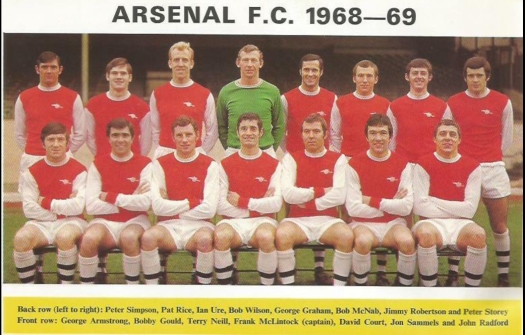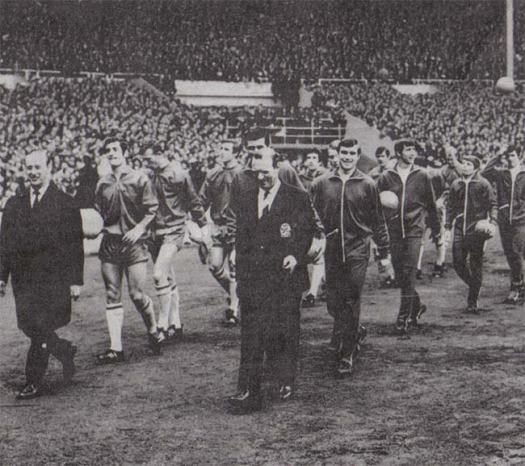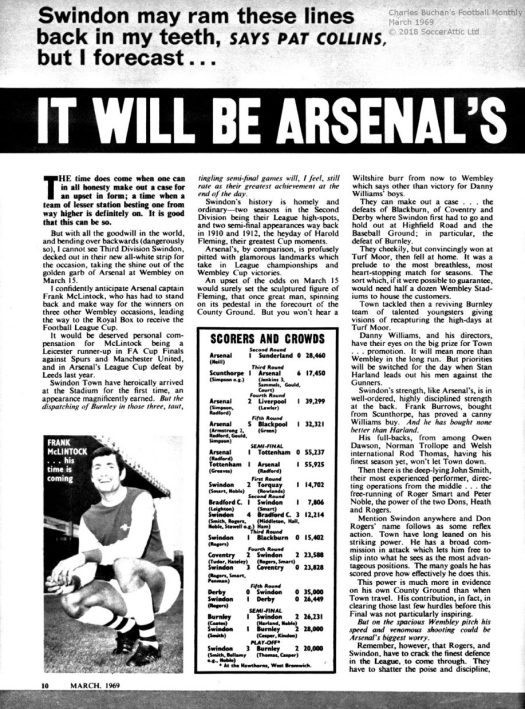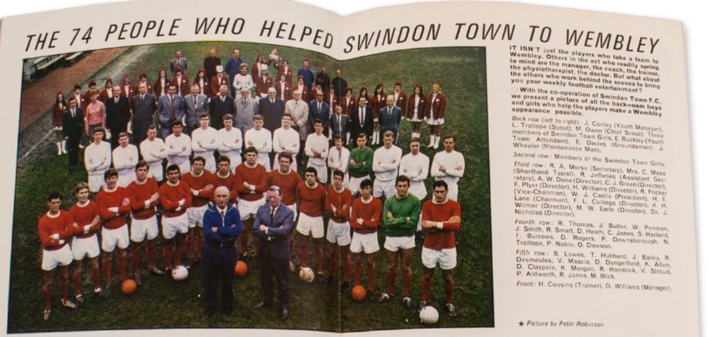In what may seem an unusual post for the Inflated Opinions website, we wanted to pay homage to the heroes we grew up with, and tell the story of one of soccer’s greatest giant killings. We hope it will inspire bravery and perseverance on a broader spectrum than just soccer.
50 years ago today, 15th March, 1969, Third Division Swindon Town humbled the mighty Arsenal in one of the biggest cup upsets in history. Here we tell that story.
Every Swindon fan, young or old, and almost every Arsenal fan, knows of this day 50yrs ago, when the super-fit no-hopers from Swindon Town defeated the mighty, yet trophy-drought-ridden Arsenal.
This is what author and fan Nick Hornby said of that day, describing how he stood on Wembley terraces as 10yr old as his dad applauded Swindon;
“I don’t remember Saturday evening, but I know that on the Sunday, Mother’s Day, I elected to go to church rather than stay at home, where there was a danger that I would watch the highlights of the game on The Big Match and push myself over the edge into a permanent depressive insanity.”
But if there was one team who lost, there was a nation of winners, as this has been called the “people’s cup triumph” – when the underdog spirit, which had made Britain great, was immortalized by a small team from the West Country with heart and soul aplenty, but who won easily (three goals to one), finishing with a goal that epitomized the English belief in a dying species – “The winger”.
Those that had seen Don Rogers play, knew he could score that “third goal” in his sleep. When “The Don” Rogers was running towards goal he didn’t see defenders – he saw lamp posts – and he’d weave between them whether the light was on or there was someone home – didn’t matter, they were going nowhere, most likely via their backside.
No the best goal is the second. It’s a stake through “the pigs heart” as Swindon manager Danny Williams would say, as the Arsenal players began to die on their feet. And it’s a beautiful piece of skill. The ball is flicked up and “The Don” uses his right foot to bring it under control all in one motion, drawing it away from a melee of defenders, then he let’s the ball drift to his left and slots it home with his “weaker foot”.
Stake through the heart. Or perhaps, ramrod down the barrel of the “Gunners” cannon.
The fact is, it was Rogers himself who had lost the ball with 4 minutes of the 90 to go. Going on yet another perpetrating run just inside the Arsenal half, he lost the ball which led to the Arsenal equalizer. George Graham slotted a through ball that the unbeatable Downsborough hesitated to come for, and instead hit the ball straight at Bobby Gould’s foot causing it to fly up into the air, landing on the Arsenal strikers head and off into the net.
Rogers was making amends.
The build up to the game is as interesting as the game itself. Good theatre often builds on previous plays. No less March 15th 1969.
The Arsenal story is one of hopeful optimism. Players who’d had difficult yet solid careers were together in a “dream team”. Take a look at the picture – many will know most of those names.

Yet at that time in 1969, many were running on hope.
Bob Wilson had been at Arsenal for 6yrs but unable to break through, held back by the solid Jim Furnell. But as Wilson likes to tell it, Furnell had one of those “howlers” he was known for, Wilson got his chance, and after great performances against the “enemy” Spurs, became first choice. Wilson quickly built a reputation for being a one v one specialist, so Roger’s third goal, leaving him on his backside, must have hurt.
Similarly, Frank McClintock was known as the nearly man, having already lost three cup finals with Leicester and Arsenal (the year before) and so saw this opportunity against div3 opposition as a gimme. After the game, such was his disappointment, that upon receiving his “runners up” tankard, he got to the bottom of the steps and threw it hard at the pitch. It sank into the mud. It summed up his, and Arsenal’s chances on that fateful day. See the players themselves recount the pain of the defeat here, from 1:56.
For the pitch could only be described as “muddy”. Unless you were an Arsenal fan, where upon, farmers field, WW1 battlefield, or just plain quicksand, still wouldn’t do. 1969 was, like 1970, a wet year, and the tradition of having the League Cup final the weekend after the Horse of the Year Show, proved to be a curse. Indeed, a year later, the FA Cup final was brought forward to give England players a rest before going off to Mexico for the World Cup, and that too suffered from the horses hooves. That said, Chelsea and Leeds were determined to make that the dirtiest cup final in history with or without the help of the hooves.
On the contrary, despite the David versus Goliath billing, the ebb and flow of the game, Swindon having never being behind, and the tiredness of both sets of players, there was only one booking in the 1969 final – Swindon’s Don Heath angry at a rare mistake by the officials and kicking the ball away. No this final was sporting and very fair, with honest tackling and good care taken. However Bobby Gould’s reckless tackle on keeper Downsborough late in normal time triggered a minor push and shove in the box, quickly extinguished by Frank Burrows – not a Scotsman to be argued with. No, most accounts in the national press, which in those days loved to give everyone scores out of 10, gave Mr Handley from Cannock (that’s how we referred to refs in those days) a hearty 9/10. To have even kept up with play on that quagmire was an achievement. To keep order, was something special.
Note also that teams were allowed only one sub in that era, and with the Arsenal team having suffered a bout of flu weeks before, one could never be enough. Those that suggest Arsenal whined after the game about the flu and the pitch are being unkind. Bertie Mee was gracious after the defeat, and all the accounts I’ve read by Arsenal players in that game paid tribute to the incredible fitness of their opponents.
For these were Danny’s Boys.
While many of the Swindon team were the remaining “green shoots” of the wonderful Bert Head youth program, they had become men under Danny Williams.
John Trollope, Don Rogers, and Roger Smart were all Swindon Youth, spawned by a program that produced Mike Summerbee and Ernie Hunt, initiated by the visionary coach Bert Head in the 1960s. When Swindon were relegated to Div 3, Head was replaced by Danny Williams, himself a loyal player for Rotherham, who still holds the club record for appearances. But in his day, he played, trained, and worked a full shift down the pit.
And it was that experience that convinced him fitness was the key to success.
So Thursday’s training was simple – 13 laps of the pitch. Don Rogers said “I used to lie awake on Wednesday nights thinking of thursdays”.
So, if you can run around the field 13 times and still remain only a distant acquaintance of your lunch, 120 minutes battling one of the country’s top sides on a quagmire was just a walk in a soggy park.
If there is one unsung hero, and there are many, it’s probably, Danny Williams’ training routine.
Swindon had gotten to the final via four replays already. In those days extra time for an evening game was rare – people had to go to work next day, and the public transport wouldn’t be there to get you home from Swindon, back to Burnley, after 9.30pm.
So instead, if a game finished all square, one typically went to the opponent’s ground first, and then if necessary, (no away goal counts double rule) a replay at a neutral ground.
After tough games against low level opposition, and the dispatching of Div 2 Blackburn, Swindon beat Division 1 Coventry (replayed) before meeting a rampant, soon to be Div 2 Champions, Brian Clough-led Derby County. Swindon won that after a replay, while Derby never lost another league game thereafter and ran away with the Div 2 title. Indeed they had been on a 14 match unbeaten run and Swindon were one of only two teams to come away from the Baseball ground with a clean sheet that season. Within two years they would be Div 1 champions and European Cup semi-finalists. And a certain Brian Clough would become a household name.
In the two leg Semifinal against Burnley, again Swindon would have to battle adversity. Burnley were the up and coming team of the 1960s, and after winning 2-1 at Burnley, they lost the home game 1-2. Incidentally, this was the first game I went to, and as an eight yr old it I tasted sorrow early. Burnley were the first team to beat Swindon at home that season, providing me with “albatross status” according to my superstitious father.
But Swindon went up to the Hawthorns, home of WBA, and played the Div 1 team off the park. 1-0 up until the 89th minute, the equalizer forced the game to an unusual extra time and Burnley immediately went 2-1 up as extra time started. The remaining 20-odd minutes saw Swindon rally, and win a thriller 3-2. The winner came from Peter Noble, who is also somewhat of a record holder, having converted all 28 professional penalties he took, a feat no one is sure has ever been matched.
It was this adversity, 2-1 down in extra time, that many Swindon players would suggest later gave them the heart to carry on after Gould’s late equalizer for Arsenal in the Wembley final.
This run in to the final, 1140 minutes, is often used as a quiz question – which team had the longest path to a cup title – certainly in UK football, probably in European football, and possibly anywhere in the World.
The final began with Mee and Williams leading their teams out onto a sandy but still intact field. This picture (below) of Mee smiling, is said to be the last sight of that smile for the rest of the weekend.

The game is also known for a rather unsavory pitch invasion by an Arsenal fan called Jack Diamond – if you’re interested read here but don’t eat first.
The game settled into a sliding brawl, and the pitch quickly churned up. Then at 35minutes Swindon went ahead through Roger Smart, who, seeing Ian Ure mess up a back pass to keeper Wilson, walked the ensuing cross into the net.
Nick Hornby was probably still emotionally scarred when he wrote “Arsenal’s best-known player was probably Ian Ure, famous only for being hilariously useless”, but Ure really struggled on that day. So too did McClintock, Storey and McNab, as Don Rogers used them as lamp posts.
That said, Arsenal rallied, and there were great swathes of attack after attack. Indeed, as Times writer Geoffrey Green put it, “for a quarter of an hour it was (keeper Peter) Downsborough versus Arsenal and Downsborough won.”
Save after save, punch after punch clear, Downsborough doggedly kept them at bay, until the 86th minute. Mee had switched the tiring Peter Simpson for George Graham at 71mins, and Arsenal finally had control of the midfield. But perversely, on a throw in, the ball spilled to, as Brian Moore noted ”that man Rogers of all people”, who went off on a run. Lamp post after lamp post, until one too many and he loses the ball, Graham feeds a searing through ball and Downsborough begins his chase to get there first. But, as he said later, “I started to come off my line and then stopped. As the ball came to me I was late on it and kicked it straight at Bobby’s foot. I was on the floor, the ball rebounded over my head and left Bobby with an easy header into the empty net. I remember wishing that the ground would open up and swallow me. I thought to myself that the one mistake could have cost us the League Cup. After all that hard work in 90 minutes of football it could have been my one moment of madness that cost Swindon the trophy. I could not believe that I had done a thing like that”.
But Downsborough’s heroics were far from over.
As the game died, Jon Samuels let fly and Downsborough was there. Samuels could be seen beating the ground with his fist, like a scene from an Orsen Wells movie. The “pig was almost dead – just bring the stake”. We went to extra time.
As extra time started, most “experts” felt confident Swindon would now buckle under the nerves and energy expenditure. They’d “had their six” as James Bond famously said in Dr No, before dispatching the baddie”
This is how one journalist explained extra time.
“The question as they went into extra time was whether Swindon could last on this stamina-sapping pitch, on which all of them were appearing for the first time.
Last? They hardly let Arsenal have a single kick in that 30 minutes of extra time.
And there could have been a fourth to add to their goal total. A drive from Trollope was sailing into the Arsenal net when it struck the referee, and all Swindon got was a corner.
In a match in which police several times had to remove turbulent Arsenal fans, only one player got into any trouble. Swindon’s Heath had his name taken for kicking the ball away in disgust when he thought a throw-in was awarded the wrong way.”
On Rogers second and Swindon’s third, Brian Moore famously said “and that’s that”.
The giants had been felled. Rogers goals either end of extra time the slingshots, hearts and souls bigger than the twin towers of Wembley, the reason. Goliath had been beaten.
Swindon went on to destroy major Italian sides in the hastily organized compensation tournaments. As a Div 3 side, the European bodies governing the InterCities fairs cup (sister tournament to the European Cup) black-balled Swindon, instead asking Southampton to take their place simple because they were geographically closest members of Div 1 – if you think Europe is bad now, read your history books.
This Swindon team would have taken Europe by storm, and in the first tournament, the Anglo-Italian cup winners cup, They destroyed AS Roma 5-2 over two legs. The Roma team included one Fabio Capella, who later said it was being beaten by Swindon that inspired him to want to come to England to coach, a task he achieved by coaching the English national team. Now they say the England manager’s job is the most difficult, and if it is, it’s because the English press have always been the toughest judge.
The Wembley losers were tortured like few before. Many journalists had confidently predicted an Arsenal first-trophy since 1953 and they were in no mood to eat humble pie alone. This is a pretty typical “It’s Arsenal” report, in Buchan’s soccer monthly.

And this is a typical post-game Mia-culpa-but-shame-on-you report by a national newspaper journalist.
“THE SHAME OF ARSENAL by Desmond Hackett
BY the time you are reading this, the football prophets – and none so unprophetic as myself – should have been on the long penitents’ crawl to Swindon. There to apologise to one of the best teams seen at Wembley.
Let us get this straight. Swindon made this Football League Cup Final. Their fighting spirit, their fitness, and their pride were a rebuke to a once-famous team called Arsenal.
Do not look to the frailties of Arsenal as an excuse for the splendour of Swindon. Look with admiration at these heroic athletes from the Third Division who reduced the traditions of Arsenal to a miserable myth. Erased forever is that match of black mourning when Walsall once upon a time long ago beat Arsenal.”
Yes, he even mentioned the terrible defeat against Walsall many years before…..
Great victories are based on multiple performances. Most settle at the team level, but in this case, it was a club. As well as the twelve who took the field that day, and the coach that led them out, there were many unsung heroes that got them there. One was Harry Cousens, the trainer. Himself a prolific player for Swindon, he joined the back room staff, and trained the first team from 1949. He is the other face you see in this picture below, and anyone who watched Swindon in that season saw he was busy every game.

Players didn’t come off lightly, and with only one sub, no wonder. So the sponge had a lot of magic to work, especially with the level of physicality of the ’60’s game. An “uncompromising wing-half, which earned him the nickname the iron man”, how do you say “it hurts too much and I need to come off boss” to a man who once played an entire season with a broken bone in his foot?
And perhaps this picture sums up Swindon Town of 1969 – everyone, including the majorettes – who played a part in this triumph, shown, and all of the back room staff, individually named.
This isn’t david versus Goliath – it’s Britain in the Blitz – Arsenal had 12 – Swindon had 74. Arsenal didn’t stand a chance.

After 50yrs, we’d have to be surprised if everyone involved was still with us.
John Smith, the engine room in the Swindon midfield, passed first, in 1988, aged 49.
Swindon captain Stan Harland,the towering gentleman, left us in 2001 aged 61. Anyone who met Stan testified that he had a heart of gold, a fair but firm Scouser who held the spirit of that team in his hands like a parent holds the hand of a child.
Last year saw the death of Willie Penman, the 12th man on the day, replacing Smith at a key time in the game. Willie played in the fledgling NASL league in USA for Seattle Sounders.
In an earlier version of this piece we omitted to mention Peter Noble passed on 6th May 2017, and we regret that. We did mentioned Peter’s contribution throughout the article, though mere words can never do that justice.
And of course, because death enjoys irony, only a month before the 50th anniversary, Danny Williams, the architect of the giant killing, passed away on 3rd February this year. The Independent newspaper wrote a fitting tribute here
On his return to Swindon, “In 1975, after West Ham avenged their FA Cup defeat, the jovial, blunt-speaking Williams memorably told reporters: “When their second goal went in, I knew our pig were dead.”
On that fateful day in March, 1969, at the end of 90 minutes, Arsenal players knew, thanks in no small way to Danny, their pig were dead too.
After the game, both sides went onto greater things.
Bob Wilson suggests this humbling defeat was the platform for the great double-winning side of 1971, and for a while, trophies became easy to find. McClintock purged that cup final ghost and became a winner, while most of the team went onto play for their country or become Arsenal legends. George Graham became both. The club stuck by Bertie Mee and the roots of a new phase of greatness were laid.
Promoted at the end of the 68-69 season, and after the Italian cup win against Roma in August of ‘69, Swindon moved into the Second Division and narrowly missed promotion to Division 1. They also won the first Anglo-Italian Cup, which saw teams like Juventus and Napoli and Roma grapple with Sheffield Utd, culminating in a riot-ended final between Swindon and Napoli in the Italian club’s stadium.
Danny Williams was lured away back to his northern roots at Sheffield Wednesday, tasked with the (impossible) job of keeping an aging side in Div 1.
Without Williams the side couldn’t be kept together and Rogers left for Crystal Palace, Welsh international Rod Thomas eventually joined the Dave McKay version of Derby County and won the Div 1 title. A sequence of poor choices for manager saw Swindon handle the wages of their loyal Wembley heroes badly, culminating in Downsborough’s departure.
In a classic case of what might have been, Swindon found themselves back in Div 3 by 1974.
Fifty years is a long time, and since that amazing giant killing at Wembley, there has obviously been success, including a season in the Premier League.
But there has never been a Swindon team to rival Danny’s Boys.



Wonderful article … thanks
LikeLike
You forgot Peter Noble R.I.P.
LikeLike
Andy Williams I wanted to mention everyone but felt then I should mention more than just the players – so Icompromised with a few.
But Peter was one i mentioned – here – possibly a pen record holder.
“The remaining 20-odd minutes saw Swindon rally, and win a thriller 3-2. The winner came from Peter Noble, who is also somewhat of a record holder, having converted all 28 professional penalties he took, a feat no one is sure has ever been matched. “
LikeLike
Great article. One of most memorable days of my life I was 13 when travelled to Wembley with my dad and sister to watch Swindon win League cup.
Looking forward to going to game tomorrow with my grandson who is also just 13 and regular supporter as well as top player himself. Hoping to see League cup and of course players who played for Swindon on that iconic day.
LikeLike
keep up the superb piece of work, I read few articles on this website and I conceive that your web site is real interesting and holds circles of great information.
LikeLike